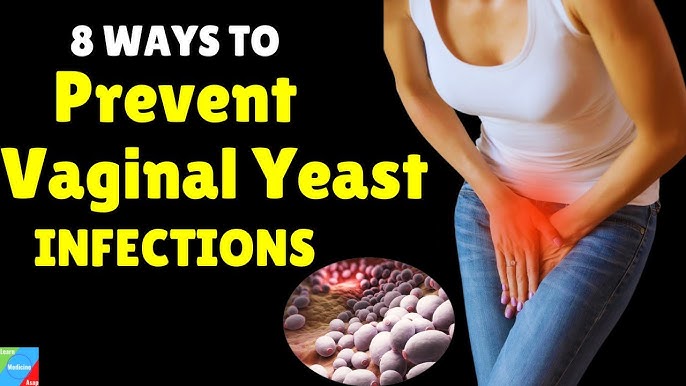Vulvovaginal candidiasis (VVC) is a prevalent fungal infection primarily caused by Candida albicans, affecting up to 75% of women at least once during their lifetime. While generally non-life-threatening, its symptoms—itching, burning, discharge, and discomfort—can significantly impact quality of life. Recurrence rates remain high without proper preventive strategies. We present an evidence-based, multifactorial approach to preventing VVC through hygiene optimization, lifestyle adjustments, targeted therapies, and microbiota support.

Understanding Vulvovaginal Candidiasis: Causes and Pathogenesis
Candida Species and Vaginal Ecology
Candida albicans is a commensal organism residing in the gastrointestinal and genitourinary tracts. Under favorable conditions—such as dysbiosis or immune suppression—it transitions into its pathogenic hyphal form, causing symptomatic infection.
Key risk factors include:
- Antibiotic use disrupting normal flora
- Hormonal fluctuations, especially estrogen dominance
- Diabetes mellitus and hyperglycemia
- Immunosuppression (HIV, corticosteroids)
- Tight clothing and poor ventilation
- High sugar intake feeding yeast overgrowth
Optimizing Vulvovaginal Hygiene to Prevent Candidiasis
Best Practices for Daily Care
- Use mild, unscented soap or plain water for external cleansing
- Avoid douching, as it disturbs the vaginal microbiota
- Wipe front to back after using the toilet to prevent contamination
- Wear breathable, cotton underwear and avoid synthetic fabrics
- Change out of wet clothing promptly, particularly swimwear and workout attire
Menstrual and Sexual Hygiene
- Change tampons and pads regularly to avoid moisture retention
- Use lubricants free of glycerin or fragrances
- Wash hands before and after genital contact
- Practice protected sex to reduce cross-contamination of Candida
Lifestyle Adjustments to Minimize Yeast Overgrowth
Nutritional Modifications
- Reduce refined carbohydrates and sugars which fuel yeast proliferation
- Increase probiotic-rich foods like yogurt, kefir, sauerkraut, and kimchi
- Incorporate anti-inflammatory foods—such as leafy greens, berries, and omega-3 fatty acids
Glycemic Control
- Maintain optimal blood glucose levels, especially in diabetic individuals
- Monitor hemoglobin A1c periodically to ensure long-term control
Stress Reduction and Immune Support
- Engage in regular physical activity, yoga, or mindfulness meditation
- Ensure adequate sleep and vitamin D intake
- Support immunity with zinc, selenium, and vitamin C
Targeted Use of Antifungal Therapies
Acute and Maintenance Treatments
| Treatment Type | Examples | Frequency |
|---|---|---|
| Topical antifungals | Clotrimazole, Miconazole | 1–7 days |
| Oral antifungals | Fluconazole (150–200 mg) | Single dose or weekly |
| Maintenance therapy | Fluconazole (150 mg) weekly | For ≥6 months |
Avoiding Antifungal Resistance
- Avoid self-diagnosis and overuse of OTC antifungals
- Confirm recurrent VVC with mycological testing
- Consider culture and sensitivity tests to tailor treatment in non-albicans species (e.g., Candida glabrata)
Addressing Recurrent Vulvovaginal Candidiasis (RVVC)
Defined as four or more episodes in 12 months, RVVC requires both acute treatment and long-term preventive care.
Diagnostic Protocols
- Confirm with wet mount, KOH prep, or culture
- Rule out bacterial vaginosis, trichomoniasis, and STIs
- Assess for diabetes, hormonal imbalances, or immune dysfunction
Long-Term Management Strategies
- Suppressive antifungal therapy (e.g., fluconazole weekly for 6 months)
- Probiotic supplementation (Lactobacillus rhamnosus, L. reuteri)
- Consider boric acid suppositories (600 mg) for azole-resistant cases
Role of the Vaginal Microbiome in Candidiasis Prevention
Importance of Lactobacilli
Lactobacilli produce lactic acid, hydrogen peroxide, and bacteriocins, maintaining an acidic vaginal pH that inhibits Candida growth.
Enhancing Microbial Resilience
- Oral probiotics containing Lactobacillus acidophilus, L. crispatus
- Vaginal probiotic suppositories to repopulate local flora
- Limit broad-spectrum antibiotic use unless medically necessary
Hormonal and Reproductive Considerations
Impact of Estrogen
High estrogen levels enhance glycogen deposition in the vaginal epithelium, promoting Candida adhesion and growth.
- Reevaluate hormonal contraceptives in recurrent cases
- Discuss estrogen-free alternatives with healthcare providers
Pregnancy and Candidiasis
- Common in second and third trimesters
- Prioritize topical antifungals; avoid oral azoles due to teratogenic risk
- Prevent vertical transmission during delivery with early detection and treatment
Public Health and Educational Outreach
Raising Awareness
- Promote educational programs in schools, colleges, and clinics
- Dispel myths surrounding vaginal infections and self-diagnosis
Screening and Access to Care
- Ensure access to diagnostic services in underserved regions
- Train healthcare providers to distinguish between VVC and other conditions
- Integrate sexual and reproductive health into primary care
Preventing vulvovaginal candidiasis requires a strategic blend of behavioral changes, therapeutic vigilance, and microbiome preservation. By addressing both intrinsic and extrinsic risk factors, encouraging evidence-based hygiene and nutritional practices, and using antifungals judiciously, we can significantly reduce the burden of recurrent infections. A unified approach involving individuals, clinicians, and public health systems is critical to maintaining lifelong vaginal health.